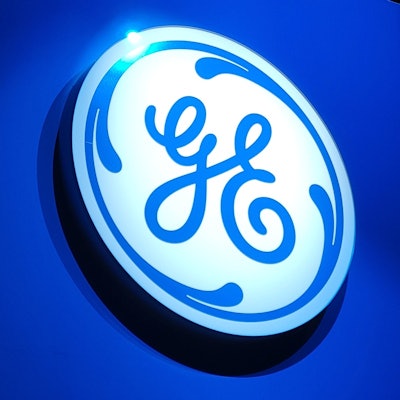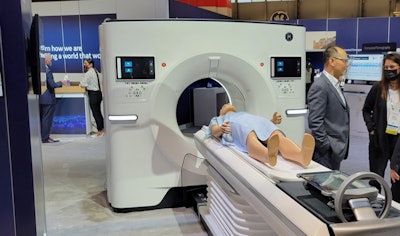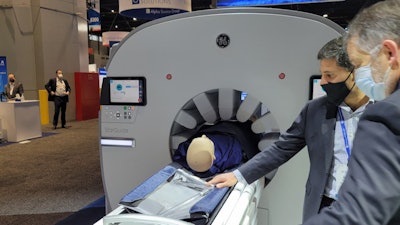
CHICAGO - GE Healthcare is launching new products across a range of medical imaging modalities at RSNA 2021, with a common theme: making radiology departments and imaging centers more efficient. The introductions include a new MRI family and a new CT scanner.
MRI
A new 3-tesla scanner called Signa Hero is the highlight in the MRI section of GE's booth at RSNA this week. The scanner includes a number of design enhancements to improve radiology operations, such as an ultrawide bore and detachable table, and all patients can be imaged feet-first to reduce claustrophobia.
 GE Signa Hero MRI scanner.
GE Signa Hero MRI scanner.Signa Hero also supports GE's artificial intelligence (AI)-based data reconstruction technology, AIR Recon DL. Use of AIR Recon DL to process MRI scans can improve image quality to appear as if it were acquired on a scanner with twice the field strength, or contribute to a 30%-50% reduction in scan times.
Technical specifications on Hero include gradients rated at an amplitude of 45 mtesla/m and a slew rate of 200 tesla/m/sec gradient; the system was also designed to use 70% less helium for magnet cooling than a conventional system. Signa Hero is pending 510(k) clearance from the U.S. Food and Drug Administration.
Signa Prime is another new scanner being launched, with GE executives describing the system as "everybody's first MRI scanner." The system was designed with a priority on making it easy to use; executives say that when the first Prime was installed in India, personnel there had it up and running in 30 minutes. The scanner sports a 60-cm bore and like Hero is designed for low helium use.
The third new scanner, Signa Artist Evo, is designed to meet the needs of GE customers who may have first acquired a magnet with a 60-cm bore but now want a wider option. GE engineers can modernize the system and convert it into a 70-cm magnet by removing the internal gradient coil, then adding AIR Recon DL processing, a faster computer, and other upgrades. FDA 510(k) clearance is pending for the scanner.
GE also is reporting that it now has 1,000 customers who have upgraded to AIR Recon DL, making it the company's fastest-selling MRI upgrade in 20 years. GE is discussing the next phase of the program, AIR Recon DL 3D, as a work in progress.
CT
New scanners are also being launched in the CT section of GE's booth. Revolution Apex is perhaps the highlight, a new scanner available in configurations based on volume of coverage, in 40-, 80-, and 160-mm of coverage.
 GE Revolution Apex CT scanner.
GE Revolution Apex CT scanner.Like Signa Artist Evo, Revolution Apex is designed to be upgraded as the needs of users change. Radiology sites can start with the 40-mm version, then upgrade to 160-mm at their leisure.
The scanner is also optimized to enhance efficiency. The system comes with a camera mounted in the ceiling of the CT suite to help radiologic technologists with patient positioning (the camera is also being made available on the Revolution Ascend platform). A site in China using Apex was able to scan 17 patients in an hour, according to the company.
Apex is available with 1,300 mAs of power reserve and a 0.23-second scan speed. It also includes GE's TrueFidelity deep learning-based reconstruction protocols, which can deliver the image quality of filtered back projection reconstruction at a fraction of the radiation dose, according to the company. GE's SnapShot Freeze 2 protocol for motion correction of cardiac studies is also available, while the company's Smart Subscription service enables customers to stay current with new software applications and upgrades.
Revolution Apex has FDA clearance, according to the company.
Finally, GE is discussing its latest advancements in motion-free cardiovascular CT, pediatric CT without sedation, and AI-powered CT radiation therapy planning.
Interventional radiology
In interventional radiology, GE is highlight upgrades and enhancements to its family of angiography systems, Allia IGS 7 and Allia IGS 5. Allia IGS 7 is the company's free-floating angiography system, while Allia IGS 5 is a floor-mounted unit.
The company has developed software that acts as a "personal assistant" to interventional personnel, helping them set up procedures and get started quickly. Likening the technology to Amazon's Alexa, or Apple's Siri, GE says users can create profiles with preset protocols that assist with room setup before the procedure.
Interventional applications that GE is highlighting at RSNA include Embo Assist with virtual injection for prostatic and renal embolizations as well as treatment of arteriovenous malformations, and Vessel Assist for brain aneurysms. Liver Assist Virtual Parenchyma supports "virtual parenchymography" to help clinicians simulate injections dynamically and perform liver embolization.
The company is also discussing the use of 3D-printed models for training vascular surgeons and Interact Structural Heart, which enables users to add CT landmarks to live image guidance modalities.
X-ray
GE is highlighting its AMX Navigate mobile x-ray system, which the company introduced in September 2021.
More efficient workflow is a major selling point of the new system, according to GE. To that end, Zero Click Exam is a protocol that's designed to improve workflow by enabling technologists to start an exam simply by scanning the patient's bar code.
The company is also discussing how the system's power-assisted Free Motion telescoping column can reduce strain on technologists by reducing by 70% the amount of lift force required to move the column.
Another x-ray highlight is Critical Care Suite 2.0, a family of AI algorithms available on the mobile system that can immediately highlight critical cases at the point of care, helping patients get treatment faster. The FDA just recently cleared the use of the software for assessing endotracheal tube placement on x-ray images, which GE says can help in the treatment of patients with COVID-19 who require intubation.
Elsewhere in GE's booth, Definium Tempo is a new midrange x-ray system that's available in two versions, Definium Tempo Plus in two axes and Definium Tempo Pro in four axes. The family was launched in September 2021.
The system is intended to offer radiologists and technologists "personal assistant" tools, with a tube-mounted console that allows for patient and protocol selection, technique modification, and positioning at the patient's side in the scanner.
The device also includes features that automate system positioning to improve ergonomics for the technologist, and its Intelligent Workflow Suite offers workflow tools that combine 3D video camera, computer vision, and video analytics, according to GE.
Finally, GE is highlighting a tomo feature for its Precision 180 remote radiography and fluoroscopy system.
Molecular imaging/Nuclear medicine
The StarGuide SPECT/CT scanner, launched in March 2021, is a major highlight in this area of GE's booth.
StarGuide is built around 12 of GE's Digital Focus detectors, which scan patients in 3D to provide more details to clinicians, and 360-degree imaging that aims to help advance precision health and support greater theranostic capabilities in nuclear medicine.
 GE StarGuide SPECT/CT scanner.
GE StarGuide SPECT/CT scanner.GE is touting the versatility of StarGuide's shape-adaptive gantry, which allows clinicians to narrow their fields of view to focus on specific body parts, including the heart and brain, to generate images with greater detail that is more difficult to attain on conventional systems. The technology allows users to redefine how bone and cardiac assessments are performed and offers the ability to scan multiple isotopes to enable simultaneous imaging in a single session.
The system has FDA clearance, and the first unit has been installed at Stanford University in California.
Women's imaging
The Invenia ABUS 2.0 automated breast ultrasound (ABUS) scanner is a highlight of GE's booth. The new version features automated assist tools to speed up exams, and GE has also secured collaboration deals with third-party software developers to improve detection of lesions and provide patient risk-assessment scores.
The second generation of GE's Senographe Pristina digital mammography system is being touted in the women's imaging section of GE's RSNA booth. The system includes the company's Efficiency Suite of applications to support more efficient operation, while contrast-enhanced spectral mammography (CESM) continues to be a point of emphasis for the company in women's imaging.
Ultrasound
The Vscan Air handheld ultrasound scanner is being emphasized in the ultrasound section of GE's booth. The scanner is wireless and fits in a clinician's pocket, making it easy to use at the point of care. The scanner was launched in March 2021.
GE is touting the scanner's dual-probe mode, which enables whole-body imaging for either deep or shallow scanning, with only the push of a button required to capture images.
Other ultrasound highlights include the Logiq P10 XDclear value-segment scanner, new AI applications for the flagship Logiq E10 scanner, and an Ultra upgrade for the Vivid E95 cardiovascular scanner.
Digital health
The major news in this area of GE's booth is a major investment in cloud-based enterprising imaging. GE is working with Amazon Web Services to develop cloud-based versions of its PACS, vendor-neutral archive, and advanced visualization software. The company will continue to offer on-premises versions of its software applications for customers that wish to retain more control over their data.



















